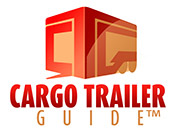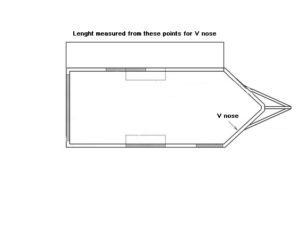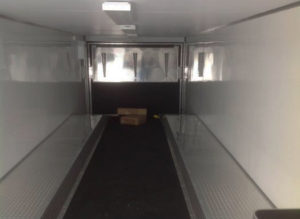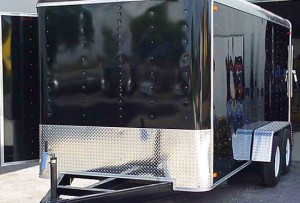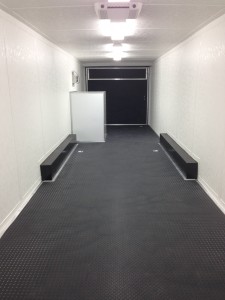At the end of the day, both will provide you with good service. It is best to make your decision based on how much you will use your trailer and your budget.
FAQ
Trailer FAQ
Certificates of Origin (the original Title from the manufacturer) are NOT transferable. If you purchase a trailer from an individual and not the dealer ship, be sure you receive a title from the individual and not a Certificate of Origin.
Most all manufacturers require warranty work to be performed at the factory. If the issue is something simple, most manufacturers will authorize the repair to be done in your local area.
If the issue is more serious, most likely they will want you to bring it back to the factory.
The reason for this can be blamed on trailer owners who falsify a warranty problem. It is very common for unethical trailer owners to not disclose that the damage was caused by an accident or some other non-warranty incident.
Some consumers will provide fake or inflated repair estimates for problems that are not warranty related.
In addition, most dealers are not equipped for any repair work.
It is important that you read your warranty document carefully and make sure to follow the procedures closely if you need to file a claim.
This will depend first on what type of mount you are using on your truck. Goosenecks will manage heavier weight and provide much better tuning radius than a bumper pull. They will also provide more stable towing by having the wight of the trailer tongue centered in the back of your truck.
Bumper pulls work great but require more attention due to their limited turning radius. Turning too sharp will cause damage to your truck and to your trailer.
If the weight of the trailer tongue is too much based on the specifications of your truck, your trucks bumper will be pushed too far down. The trailer will behave erratically while being towed and excessive tire wear will occur. You could easily lose control of your vehicle and your trailer.
Towing a trailer is serious! Please make sure to always comply with the tow rating of your vehicle.
Be sure to check our state laws and regulations page. Laws vary with different states.
Trailers are built based on the buyer’s order which should be in writing. If something is not on the order, most likely it will not be on the trailer. It is the responsibility of the buyer to make sure the order is reviewed carefully and make sure the features and specifications are clearly listed. It is best to sign and date your order when it is exactly as you want it. If you change your order, it is best to sign and date the change order as well.
It is important to understand that most dealers are very busy and have a high volume of incoming telephone calls. Making sure your order is signed and dated will greatly reduce the chance for errors due to miscommunication.
This is a common point of confusion between the buyer and dealer. Inside height of a trailer is measured to its highest point. If the specs say a trailer has an inside height of 7 feet, this does not mean that the entire inside of the trailer is 7 feet high. Most trailers have bows in the ceiling. Height measurements are measured to the peak bow height which is normally the center. The inside height beside the walls can be much lower than the center.
If you require the entire clearance height inside your trailer to be a specific height, make sure this is written clearly on your order. Ex: “Entire inside trailer finished ceiling height requirement …” Notice that the example included the word “finished”. It is important to understand that when a buyer wants a ceiling to be finished (covered with plywood or other material) this will reduce the inside clearance height by the thickness of the material. If a buyer orders a 7 foot inside height and wants it finished with ½ inch plywood, the inside height will be 6 feet 6 inches.
MAKE SURE TO SPECIFY ON YOUR ORDER WHAT INSIDE FINISHED CLEARANCE HEIGHT YOU NEED, AND IF YOU NEED THE CLEARANCE TO BE THE ENTIRE INSIDE OF THE TRAILER, NOT JUST THE HIGHEST POINT.
Inside width of a trailer is measured to its widest point. If the specs say a trailer has an inside width of 7 feet, this does not mean that the entire inside of the trailer is 7 feet wide. If the trailer has inside fender boxes, they are not included in the measurement. This means that the inside width will be narrower in the area between the fender boxes.
If you require the entire width inside your trailer to be a specific width, make sure this is written clearly on your order. Ex: “Entire inside trailer finished width requirement …” Notice that the example included the word “finished”. It is important to understand that when a buyer wants the walls to be finished (covered with plywood or other material) this will reduce the inside width by the thickness of the material. If a buyer orders a 7 foot width and wants it finished with ½ inch plywood, the inside width will be 6 feet 6 inches.
MAKE SURE TO SPECIFY ON YOUR ORDER WHAT INSIDE FINISHED WIDTH YOU NEED, AND IF YOU NEED THE WIDTH TO BE THE ENTIRE INSIDE OF THE TRAILER, NOT JUST THE WIDEST POINT.
Note: If the narrower area between the fender boxes is not going to be wide enough, ask your dealer if they can install fender box ramps. These are ramps that will allow you to drive over the fender boxes.
Trailer outside dimensions are measured from outside of the box. For example, a 7’ X 16’ trailer means that the trailer is 7 feet wide from outside one side of the box to the outside of the other side of the box. The trailer length is 16 feet from the back of the box to the front, but only the rectangle portion of the box.
If the trailer is a “V” nose, the length normally is not included in this measurement. Many “V’ nose trailers add an additional 2 feet to the length of the trailer. In summary, a 24 foot “V” nose trailer may be a total of 26 feet, measured from the farthest point in the front to the back of the trailer.
Outside height: Keep in mind that the eight is measure from the form the bottom of the box to the top of the box. IT DOES NOT INCLUDE ROOF VENTS AND OTHER INSTALLED ITEMS.
MAKE SURE TO ASK YOUR DEALER HOW THEY MEASURE THEIR TRAILERS BEFORE YOU PLACE YOUR ORDER TO AVOID ANY POSSIBLE MISCOMMUNICATION.
Door opening height is specified separately from inside height. If the inside height is said to be 7 feet, this does not mean the door clearance height is 7 feet. Many openings are 6 inches lower than the ceiling height. Also, keep in mind that depending on the angle of your ramp and if it is going to have a beaver tail, you may need more door clearance height than the actual height of the item you are loading.
MAKE SURE THAT THE DOOR CLEARANCE HEIGHT YOU NEED IS CLEARLY LISTED ON YOUR ORDER.
Before purchasing a trailer, you should consult the owner’s manual of your tow vehicle. It will list your vehicle’s maximum towing capacity.
The number of axles you need depends solely on the amount of cargo weight you intend to transport. Make sure to take the time to do your research. Most if not all the weight information you need can easily be found on the internet.
Important! If you cut corners to save money and not have the number of axles needed to haul your cargo weight, the structure of your trailer may fail. This could result in serious injury to you and others, and possibly destroy your trailer and other vehicles.
Having not enough axles for the weight of your cargo will also effect the way you trailer handles while towing it down the road. It will also cause excessive and uneven wear of your tire and cause damage to you wheel bearings and other parts of your trailer.
A tire could easily rupture, causing you to lose control of your vehicle and the trailer.
In the end, its best to configure your trailer to hold a more than your expected cargo weight. In addition, damage caused from overloading your trailer will not be covered by warranty.
Be sure and provide accurate information to your dealer so they will make sure you purchase a trailer with the right number of axles.
The recommended tire pressure is clearly labeled on all tires, and should be routinely checked before and after trailer use.
All trailers have a stated GVWR or Gross Vehicle Weight Rating. This weight is the amount that can safely be loaded into the trailer,including the trailer weight. In other words, to calculate how much you may haul, you should subtract the weight of the trailer from the GVWR.
Our website was designed especially for people just like you.
First, read our page on “How trailers are built”. Understanding the basics of how trailers are constructed will help you in your buying process.
Then you need to decide what brands you prefer. This is done by going to our brand page and using our “Brand Filter” and select what features you think you need. If you are not sure, then select only the basic features that you know for sure you need.
All brands will be filtered based on the features you selected. Then click on each dealer to read their profile and most importantly, the user reviews score and comments.
When you have narrowed down your choice of brands, click the button to “Find Dealers”. The list of dealers who sell those brands will then be displayed. This time use our “Dealer Filter” to narrow down the dealers you want to work with.
The new list of filtered dealers will be displayed.
Now! You have two choices:
1. If you need a custom built trailer and don’t think you will be able to find one in our Classifieds, simply click on the button beside the dealers info and “Get a Custom Quote”. After choosing what features you want and clicking “Submit”, the dealer will receive your request and contact you with their quote.
2. Click on the Classifieds button. Our Classifieds will allow you to select specific trailer features. A list of trailer ads will then be displayed for you to review and compare. Unlike other online classifieds, each of our ads are formatted exactly the same. That makes it very easy for you to compare each ad specifications.
If you find terminology on our site that you do not understand, be sure and refer to our Trailer Glossary.
As with any business, some dealers are better organized than others so response times may vary. Dealers can also get overwhelmed with phone calls from other trailer buyers and simply get behind.
It is important to us that dealers respond to all quote requests in a reasonable period of time. If you have not received your quote yet, we want you to make us aware by clicking on the button below. We will then contact the dealer to remind them about your quote request.
Also, please make sure to leave a review for that dealer here on our web site. Simply click here on Dealer or the button on our front page.
I have not received a quote yetAsk you dealer to have your trailer built with a beaver tail. This means that the last several feet of the trailer floor slopes downward, giving you more door height clearance.
This can prevent you from having to have the entire trailer built taller.
MAKE SURE THAT THE DOOR CLEARANCE HEIGHT YOU NEED IS CLEARLY LISTED ON YOUR ORDER.
This depends completely on the weight of your cargo and what it is that you intend to transport. Take the time to research the weight of your cargo. Most if not all of the weight information you need can easily be found on the internet.
Important! If you cut corners to save money and not purchase the right axles needed to haul your cargo weight, the structure of your trailer may fail. This could result in serious injury to you and others, and possibly destroy your trailer and other vehicles.
Having axles that are not rated for the weight of your cargo will also effect the way you trailer handles while towing it down the road.
It will also cause excessive and uneven wear of your tire and cause damage to you wheel bearings and other parts of your trailer.
The axles could bend and and a tire could easily rupture, causing you to lose control of your vehicle and the trailer.
In the end, its best to configure your trailer to hold a more than your expected cargo weight. In addition, damage caused from overloading your trailer will not be covered by warranty.
Be sure and provide accurate information to your dealer so they will make sure you purchase a trailer with the right weight rating.
No. Most often this means that only the tail lights will be LED.
If you want all lights on your trailer to be LED, make sure it is clearly listed on your order.
No.
Door opening height is specified separately from inside height. If the inside height is said to be 7 feet, this does not mean the door clearance height is 7 feet. Many openings are 6 inches lower than the ceiling height. Also, keep in mind that depending on the angle of your ramp and if it is going to have a beaver tail, you may need more door clearance height than the actual height of the item you are loading.
MAKE SURE THAT THE DOOR CLEARANCE HEIGHT YOU NEED IS CLEARLY LISTED ON YOUR ORDER.
No.
Trailer cargo capacity is measured as dispersed weight as is the ramp. This means that if you trailer is rated to carry 10,000 lbs. of cargo, that does not been that it can hold 10,000 in a small area.
Example: You have a forklift that weights 10,000 lbs. and your trailer is rated to carry 10,000 pounds. Because the weight of the forklift is confined to a small area, the ramp may not be able to hold your forklift.
Make sure that your dealer knows what you intend to carry and its weight, and that these requirements are listed on your order.
Perhaps not.
Trailer cargo capacity is measured as dispersed weight. This means that if your trailer is rated to carry 10,000 lbs. of cargo, that does not been that it can hold 10,000 lbs. in a small area.
Because the weight of the forklift is confined to a small area, the trailer may not be able to hold your forklift.
This issue also applies to the weight capacity of the ramp.
Make sure that your dealer knows what you intend to carry and its weight, and that these requirements are listed on your order.
Make sure to choose the right tires for your specific application.
Due to their affordability, many trailers come with bias tires. Radial tire are often an upgrade.
Bias tires heat up faster than radial which makes them suitable for local driving.
If you are going to tow your trailer beyond you local area, you should consider upgrading to radial tires.
If you choose the wrong tires, they could rupture from overheating and leave you stranded beside the road far from help. Ruptured tires can cause damage to your trailer and cause you to lose control of your vehicle and your trailer.
If radial tires are better, why do they put them on trailers?
The trailer business is very competitive. The added cost of radial tires will cause many buyers to ignore ads with a slightly higher price. They will not get the opportunity for a dealer to explain why their price is a little more and the benefits and danger of not purchasing the right tires for their trailer.
Yes, even though your state may not require a license plate and or tag. As discussed in another question, certificates of origin are NOT transferable. Therefore, when you want to sell your trailer, you can not transfer the Certificate of Origin. Also, if you lose your Certificate of Origin, you can not apply for a lost title at your local DMV if the trailer was never registered.
The narrower area between the fender boxes can be too narrow for your cargo. Fender box ramps allow you to drive over the fender boxes, maximizing all the inside width of your trailer.
Aluminum tread plate (ATP) is aluminum that comes in rolls and can be used to cover the floor, walls, and outside areas of a trailer.
It normally has a diamond like pattern but patterns can differ depending on brand. It is normally glued down when applied to the inside walls or floors but attached with screws when used on the exterior of the trailer.
On the outside it is used as a stone guard around the bottom portions of the trailer where rocks and other debris might fly up and cause damage to the trailer exterior. These areas are along the bottom sides and front lower areas but it can be used most anywhere.
Rubber tread plate (RTP) is a rubber floor matting that comes in rolls and is glued to the top of the trailer floor. Patterns differ depending on the brand.
It provides obvious advantages compared to bare plywood or OSB. It is water proof, oil resistant, and it’s not as slippery as bare floors.
In general, the trailer industry (enclosed) considers anything beyond a basic trailer to be an options trailer. Basic means that it has a standard plywood or OSB floor, no floor covering, insulation, no special lights or wiring, etc.
There are many options available depending on the brand. They can be simple such as rubber tread plate (RTP) floor covering, to bathrooms, A/C/ generators, live in quarters, cabinets, and many others.
Option trailers take longer to build than standard (cookie cutter) trailers. When a basic trailer has been completed, it then must go to the options department. Most of the time the options department is backlogged which ads even more to the time for options to be completed. Actual work time needed to complete the options depends on the complexity of the options.
Even though it may take longer to get an options trailer completed, it is well worth the time to have these features installed right at the factory.
There are companies available that only provide installation of options.
A. Upon your purchase of a new trailer, it is very important to check your lug nuts for tightness. Rims on trailers must become seated to the hub of your trailer. Lug nuts may work loose on your new trailer. To be safe check your lug nuts upon initial purchase and then every 50 miles until the rim has seated to the hub.
B. Trailer axle hubs require lubrication. Unless your trailer is equipped with easy lube hubs, you must remove the hub and pack it with grease. Check hub lubrication every 6 months or 10,000 miles, whichever comes first. The maintenance schedule would be the same as above.
C. Lights should be checked before each use. Your new trailer should have been checked at the factory but you should check it again to insure that all of the lights are working properly. Bulbs may blow or wires may become frayed or broken as you use your trailer.
D. If your trailer is equipped with brakes, check to make certain that they are operable before each use. Also, make sure the emergency brake pin is fully inserted into the break away switch.
E. Check your tires before each use. Tire life expectancy is dependent upon proper tire inflation. Recommended tire pressure is
found on the sidewall of the tire. Check tires for cuts, flat spots, or dry rot periodically.
F. Your trailer coupler is a very important component on your trailer. Couplers should be checked before each use to insure safe towing. Check coupler for excessive wear, broken or bent components, and proper fit. To extend the life of your coupler add grease to the socket of the coupler to reduce wear. Always make sure that the proper ball size is used on your tow vehicle. Check to make certain that your coupler is properly latched before each tow.
G. Axle bolts should be checked periodically to insure that no parts have been broken or have worked loose.
H. Sealants should be checked every 6 months or as needed for cracks or breaks. For cracks or breaks in seals, simply
reapply a silicone sealant as needed.
I. Periodically check the screws on your trailer to insure that road vibration has not worked any of them loose.
Many single axle trailers are equipped with a 2? coupler.
Tandem axle trailers are often equipped with a 2 5/16? coupler.
Coupler size varies with each manufacturer.
Normally, the size ball needed is listed on the coupler. You should also check with your dealer just to be safe.
DANGER! FAILURE TO USE THE PROPER HITCH BALL SIZE CAN RESULT IN YOUR TRAILER BECOMING UNCOUPLED CAUSING SERIOUS INJURY OR DEATH!
The coupler on you trailer tongue will specify the size trailer ball you need. Be sure to ask your dealer what size you need.
Important! NEVER TOW A TRAILER WITH A TRAILER BALL THAT IS NOT THE SIZE SPECIFIED ON THE COUPLER.
Trailers can quickly jump off the ball while you are towing it at high speeds down the road. This could result in causing a serious accident and possibly loss of life.
Opinions vary on this subject and are based largely on personal preference.
Leaf Spring
Leaf spring axles are the most common axle found on trailers due to their affordability. They have flat, curved leaves stacked on top of each other in several layers. The leaf springs themselves are attached directly to the trailer frame, not the axle.
Although they may need more maintenance than torsion axles, their parts are replaceable .
If a tire on your trailer goes over a pothole or lower place in the road, other tires on your trailer may not remain in contact with the road surface. This is because the leaf springs do not function as independently as torsion axles.
Torsion
Torsion axles are attached directly to the trailer frame thereby providing more trailer rigidity. This method of attachment also reduces flex in cross winds and on rough roads.
They have adjustable ride height and a rubberized suspension system. Inside the axle housing there are four rubberized cords. As each wheel moves up and down, the rubber cords compress resulting in an even wheel suspension system for a smooth ride.
The axle tube is galvanized inside and out to reduce the chance of corrosion and there is no metal-to-metal.
Warranty is always provided by the manufacturer, not the dealer. Refer to the warranty documents that you should have been provided when you purchased your trailer. If you can’t locate them, your dealer will be able to provide you with that information.
No. Every state has different requirements for transporting a trailer through their state. It is impossible for a dealer to be able to comply with the requirements of every state.
If you get stopped by law enforcement, much will depend on what they decide. Some states are very cooperative while others are not.
Be sure to have your MSO (manufacturers statement of origin) and your Bill of Sale with you at all times. Police officers will often not give you a problem if you have these documents but in the end, it is up to them.
Transporters that are DOT licensed and insured have special tags that are in compliance with every state. If you choose to hire someone to deliver your trailer to you, always make sure that they prove they are DOT licensed and insured.
If you the transporter you hire is not licensed and gets stopped by law enforcement, your trailer could be impounded and you may be responsible for all fines and fees.
Website FAQ
As with any business, some dealers are better organized than others so response times may vary. Dealers can also get overwhelmed with phone calls from other trailer buyers and simply get behind.
It is important to us that dealers respond to all quote requests in a reasonable period of time. If you have not received your quote yet, we want you to make us aware by clicking on the button below. We will then contact the dealer to remind them about your quote request.
Also, please make sure to leave a review for that dealer here on our web site. Simply click here on Dealer or the button on our front page.
I have not received a quote yetCargotrailerguide.com has a button on dealer pages that allow you to get quotes with ease. By clicking on the button, simply complete the specification form for your trailer and then submit it directly to the dealer. The quote will be sent back to you so you can easily compare them with other dealer quotes.
I have not received a quote yet* Please make sure to use our trailer reviews to leave comments and rate your experience with Dealers and Brands.
